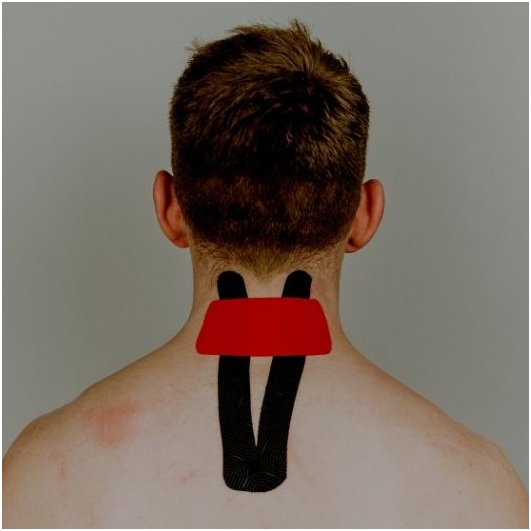
Kinesiology tape has become a therapeutic tool for managing musculoskeletal conditions and promoting recovery. It is common to see gyms swarming with members flashing colorful tapes across their bodies to improve their performance while working out. While commonly used in sports environments, k-tape significantly benefits people with cervical spine and back issues. This article explores why applying kinesiology sports tape to the cervical spine can benefit people by reducing pain and helping them maintain their technique to avoid further injury.
The cervical joint, which refers to the joints in the neck region of the spine, the cervical joint plays a crucial role in athletes’ overall performance and well-being. The cervical joint functions like the shoulder and knee as it can rotate while moving forwards and backward. On the body, it is one of the more complex biomechanical structures.
The cervical joint provides stability to the head and neck, allowing athletes to maintain proper alignment during various physical activities. This stability is essential for maintaining balance, coordinating movements, and preventing injuries, especially in sports that involve rapid changes in direction, jumping, or physical contact. Think basketball players suddenly shifting direction or even powerlifters correcting form as they pull weights off the ground.
The Importance of the Cervical Spine
The joint allows for a wide range of motion in the neck, enabling athletes to have better visual awareness and adaptability during sports activities. Athletes need to be able to turn their heads and look in different directions quickly and efficiently. A well-functioning cervical joint facilitates optimal performance and smooth and unrestricted movements. In precision sports like shooting or archery, cervical motion is most important as it is part of full-body coordination and accuracy.
In sports that involve contact or impact, such as football, rugby, or martial arts, the cervical joint acts as a shock absorber. It helps dissipate the forces generated during collisions or falls, reducing the impact on the head and neck. This helps protect athletes from severe injuries, including concussions, spinal cord injuries, and whiplash. Proper alignment of the head and neck is crucial for maintaining good overall posture. The cervical joint supports the head’s weight and helps align the spine. Athletes with more proper posture are likely to achieve optimal performance, as it allows for efficient movement, better breathing, and reduced risk of muscle imbalances or strains.
Any martial practitioners familiar with proper techniques to perform more complex throws or higher kicks know the importance of a healthy and robust cervical joint. It functions to perform these motions correctly and help with the execution to help get the win.
What Does the Cervical Spine Do?
The cervical spine starts at the base of the skull and is made up of the following seven vertebrae down; it ends just above the thoracic spine. The cervical spine is shaped much like an inverted letter C. The cervical spine’s primary function within the human body is to protect the spinal cord as it exits the skull.
The cervical joint houses and protects the spinal cord, which transmits nerve signals between the brain and the rest of the body. Any dysfunction or misalignment in the cervical joint can interfere with nerve function, leading to pain, numbness, tingling, or weakness in the upper extremities. Maintaining a healthy cervical joint is vital for optimal nerve function and athletic performance.
One of the primary benefits of using kinesiology tape on the cervical spine is the improved stability and support it provides. The tape’s elastic properties allow it to mimic the natural movement of the muscles and joints, promoting proper alignment and reducing strain on the neck. External support helps stabilize the cervical spine, reducing the risk of further injury and enhancing overall comfort.
How Can Kinesiology Tape Help?
Poor posture is a common problem that can contribute to cervical spine issues. Kinesiology tape can be applied to the neck and upper back area to encourage proper posture. Removing the shoulders back and supporting the neck reminds the wearer to maintain an upright position, reducing stress on the cervical spine and improving overall alignment.
Restricted range of motion is a common concern for individuals with cervical spine issues. Kinesiology tape can help address this by gently stretching the muscles and soft tissues around the neck. This stretching effect can help improve flexibility and increase the range of motion in the cervical spine, allowing for greater freedom of movement.
Kinesiology tape’s unique wave-like pattern and elasticity can facilitate lymphatic drainage. The tape’s application helps to lift the skin slightly, creating space for improved circulation and lymphatic flow. K-Tape can be particularly beneficial for individuals with swelling or inflammation in the neck area, as it promotes removing waste products and reduces edema.
Also Read: Know About Invisalign Braces in London
Muscle fatigue is common in individuals with cervical spine issues, often due to muscle imbalances or overexertion. Kinesiology tape can help reduce muscle fatigue by supporting tired or overused neck and upper back muscles. Distributing the load more evenly can help prevent excessive strain on specific muscles and promote better coordination.
Applying kinesiology tape to the cervical spine can effectively support the neck, alleviate pain, and promote recovery. However, proper application is crucial to maximize its benefits. This article will guide you through applying kinesiology tape to the cervical spine.
How to Apply Kinesiology Tape?
Before applying kinesiology tape, ensure that the skin in the target area is clean, dry, and free from lotions or dirt. Shave any excessive hair if necessary, as it may interfere with the tape’s adhesion.
Measure and Cut the Tape
Start by measuring the appropriate length of kinesiology tape for the cervical spine. Cut the tape into two equal strips. The length will vary depending on the size of the individual and the desired coverage area. A general guideline is to cut each strip to approximately 10-12 inches.
Positioning the Neck
Tilt your head forward to stretch the skin on the back of your neck. This position helps to create tension and facilitate the proper application of the tape. It is essential to maintain a comfortable posture throughout the process.
Applying the First Strip
Take one of the cut strips of kinesiology tape and remove the backing. Start by anchoring the tape at the base of the neck, just above the shoulders. Apply the tape vertically along the spine, following the natural curve of the cervical region. Apply gentle tension to the tape as you move upward. Avoid applying excessive tension to prevent skin irritation.
Applying the Second Strip
Repeat the same process with the second strip of kinesiology tape on the opposite side of the spine. Applying the second strip will provide additional support and stability to the cervical spine. Again, start at the base of the neck and apply the tape vertically along the spine, using gentle tension.
Smoothing and Activation
Once both strips are applied, use your fingers or a rounded-edge tool to smooth the tape. The stretching and smoothing of the kinesiology tape help to activate the adhesive and ensure proper adhesion to the skin. Rub the tape gently to create heat and friction, enhancing adherence. The heat will help activate the glue.
Finishing Touches
Trim any excess tape if necessary. Be sure to round the edges of the tape to prevent premature peeling. The short tape will also enhance comfort and prevent catching on clothing or other objects.
Post-Application Care
Once the kinesiology tape is applied, avoiding excessive moisture, such as excessive sweating or direct contact with water, is essential to ensure longevity. The tape can typically be worn for several days, depending on individual needs and skin sensitivity. If you experience any discomfort or irritation, remove the tape and consult a healthcare professional.
The removal process of the tape is simple. Wash the area with warm water, and rub with soap. When you feel the adhesive slipping, peel the tape off toward how the hair grows on the body. Remember that pulling against the hair will pull it out and may cause irritation and, worse, bleeding.
If the tape feels stubborn and using soap and water does little to lose the adhesion to the skin, do not panic. Feel free to apply baby oil to the tape. Let the oil soak into the tape. It should loosen up in 15 or 20 minutes. Once the glue has loosened its grip, pull and remove.
The proper use of K-tape can help the health of the cervical spine and thus promote overall health. For sports enthusiasts, it can help in performance by lowering pain and helping with technique. So feel free to use the sports medicine tool to help in everyday life.






